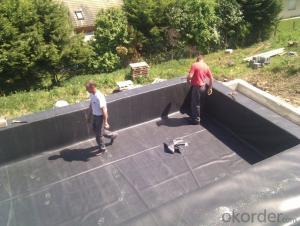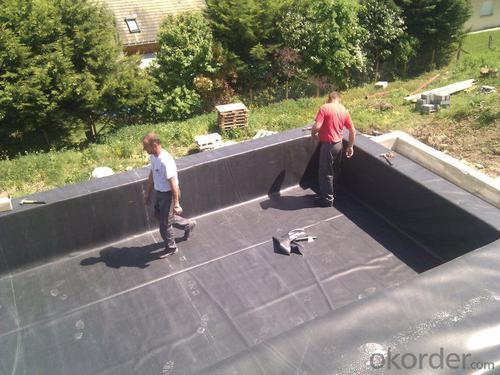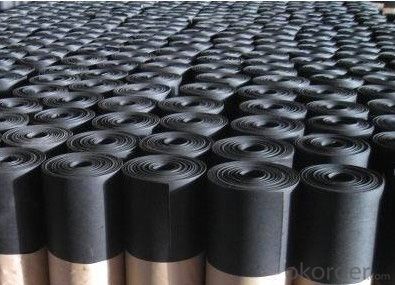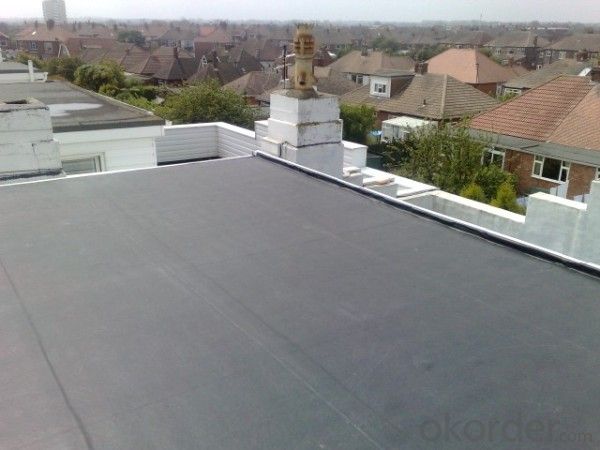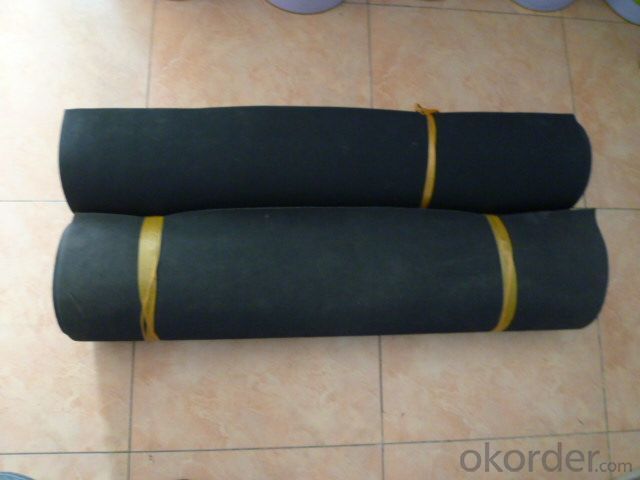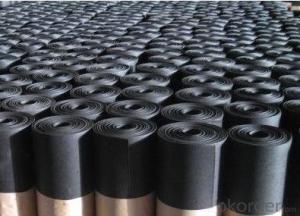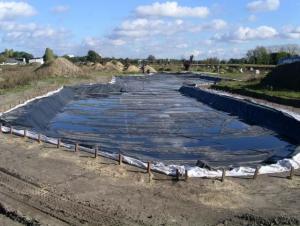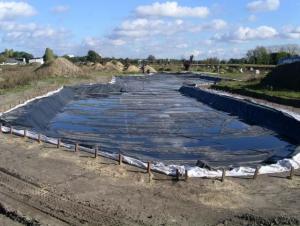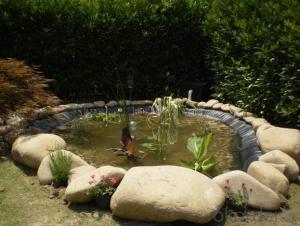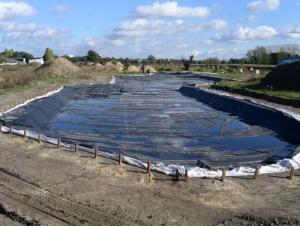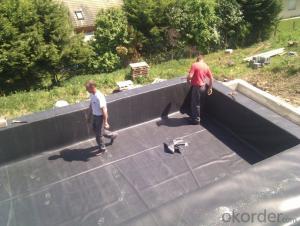EPDM Rubber Coiled Waterproof Membrane for Fish Pond
- Loading Port:
- Shanghai
- Payment Terms:
- TT OR LC
- Min Order Qty:
- 50000 m²
- Supply Capability:
- 5000000 m²/month
OKorder Service Pledge
OKorder Financial Service
You Might Also Like
EPDM Rubber Coiled Waterproof Membrane for Fish Pond
Description Of EPDM Rubber Coiled Waterproof Membrane for Fish Pond:
•EPDM waterproof sheet has excellent anti-ozone-aging performance, able to resist ultraviolet light and corrosion of many chemical corrosive materials in the atmosphere
•It has high tensile strength, high ductility and strong retractility, it has excellent crack resistance, able to effect waterproof function even with tiny vibration of buildings.
• Excellent resistance to ozone, oxidation and sunlight.
• Resistance to chemicals; resistant to most inorganic products.
Main Features of EPDM Rubber Coiled Waterproof Membrane for Fish Pond:
1>Excellent antiaging performance, service life up to 50 years
2>Working well with in 40C to 100C,it canbe constructed with a single layer in ambient temperature.
3>Waterproofing on various kinds of underground project,industrial of civil buildings and structures.
4>high extension rate, high tensile strength, small size changes at heat treatment
5>Good plant roots penetrability resistance and can be made waterproofing layer of planting roof
6>Special modified molecular structure ,effectively resolving the current domestic and foreign glue joint problem.
7>Good low temperature flexibility, and good performance of adapting to ambient temperature changes.
8>Convenient application ,solid joint, no environment pollution
9>chemical corrosion Resistance, can be used for special occasions
10>Convenient maitenance, low cost.
Specifications of EPDM Rubber Coiled Waterproof Membrane for Fish Pond:
| Material | EPDM Rubber |
| Size | 1.2m (width)*20m (length) or customized, weldable type 2.05m or 4m width |
| Thick | 1.2mm, 1.5mm, 2.0mm |
| Type | Vulcanized & Weldable |
| Pattern | Non-reinforced (homogeneous) |
| Certificate | ISO9001/14001 |
Applications of EPDM Rubber Coiled Waterproof Membrane for Fish Pond:
Widely used in roofs, basement, toilet ,swimming pool, and all kinds of industry and civil building waterproofing, reservoir, vivicism, bridge, underground, tunnel and dam waterproofing ,especially to the keystone waterproofing projects which is durability, high corrosion resistance and easy deformation.



IMages of EPDM Rubber Coiled Waterproof Membrane for Fish Pond:




FAQ of EPDM Rubber Coiled Waterproof Membrane for Fish Pond:
1. What are we supplying?
We are specialized in producing Colorful Asphalt Roof Shingle, SBS/APP modified bitumen waterproof membrane, Self adhesive bitumen waterproof membrane, PVC waterproofing membrane, EPDM rubber roofing membrane, Single Component Polyurethane Waterproof Coating, and Spray Polyurea Waterproof Coating
.
2. How Many years experience do we have?
We have been exported to more than 20 countries in the past 15 years.
3. How long do we usually reply your request?
We always reply our customer within 24 hours.
- Q: Can a waterproofing membrane be used on terrazzo surfaces?
- Yes, a waterproofing membrane can be used on terrazzo surfaces. Terrazzo is a durable and long-lasting material, but it is porous and can absorb water if left untreated. Applying a waterproofing membrane helps protect the terrazzo surface from moisture damage, preventing water penetration and potential issues such as staining, cracking, or mold growth.
- Q: Are waterproofing membranes suitable for high-traffic areas?
- Waterproofing membranes prove to be an ideal solution for areas with high foot traffic. Their purpose is to create a barrier against water infiltration, safeguarding the structure and preventing water-related harm. It is worth noting that high-traffic zones like walkways, driveways, parking lots, and other heavily frequented spaces are at risk of continuous exposure to water, resulting in structural damage and gradual deterioration. By employing waterproofing membranes in these areas, water penetration is effectively thwarted, guaranteeing their resilience and longevity. Furthermore, these membranes are often engineered to be slip-resistant, adding an extra layer of safety in high-traffic zones. Consequently, implementing waterproofing membranes in such areas is a prudent decision to address water-related concerns, preserve the structural integrity of the space, and ensure the safety of its occupants.
- Q: Can waterproofing membranes be used on bridge decks?
- Yes, waterproofing membranes can be used on bridge decks. Bridge decks are constantly exposed to harsh weather conditions, including rain, snow, and freeze-thaw cycles, which can lead to the deterioration of the concrete and steel reinforcement. Waterproofing membranes are designed to prevent water infiltration and protect the bridge deck from moisture-related damage. These membranes are typically made of flexible materials such as bitumen, PVC, or EPDM rubber, and they are applied directly onto the bridge deck surface. The waterproofing membrane acts as a barrier, preventing water from seeping into the concrete and causing corrosion of the reinforcement. It also helps to reduce the formation of cracks and extends the service life of the bridge deck. Additionally, waterproofing membranes can be combined with other protective coatings or systems to enhance their effectiveness and durability. Overall, the use of waterproofing membranes on bridge decks is a common and effective method to ensure the long-term integrity and functionality of the structure.
- Q: Can a waterproofing membrane be used for plant rooms or mechanical spaces?
- Yes, a waterproofing membrane can be used for plant rooms or mechanical spaces. Plant rooms and mechanical spaces are areas where equipment, machinery, or systems are installed, and they often contain pipes, tanks, or other components that require protection from water damage. A waterproofing membrane is a durable, flexible, and watertight barrier that can be applied to surfaces such as walls, floors, or ceilings to prevent water infiltration. By using a waterproofing membrane in plant rooms or mechanical spaces, you can ensure the longevity and functionality of the equipment and systems by protecting them from water leaks or moisture damage. Additionally, a waterproofing membrane can also provide a vapor barrier, preventing the buildup of condensation or humidity, which can be detrimental to sensitive equipment.
- Q: Can a waterproofing membrane be used in bathrooms?
- Indeed, bathrooms can benefit greatly from the utilization of a waterproofing membrane. It is strongly advised to employ such a membrane in bathrooms as a preventive measure against water-related harm and leakage. Typically, this membrane is applied to both the walls and floors, establishing a protective barrier that inhibits water infiltration, subsequently averting structural deterioration or the proliferation of mold. This is particularly crucial in areas of heightened water exposure, such as showers and the vicinity of bathtubs. These waterproofing membranes are engineered to endure moisture and offer enduring safeguarding, thereby assuring the soundness of the bathroom and prolonging its longevity.
- Q: Is a waterproofing membrane resistant to UV radiation?
- Yes, a waterproofing membrane is typically resistant to UV radiation. This is because most waterproofing membranes are designed to withstand exposure to sunlight and other environmental factors, ensuring long-term durability and protection against UV radiation.
- Q: Can a waterproofing membrane be used for tunnels and underground structures?
- Tunnels and underground structures necessitate the use of a waterproofing membrane to combat water infiltration and safeguard against potential water damage. Such membranes are commonly employed in construction to create a barrier against water and are particularly vital in these situations due to the increased risk of water ingress from surrounding soil and groundwater. The integrity and longevity of the infrastructure rely on waterproofing membranes in these environments. Waterproofing membranes designed for tunnels and underground structures are specifically engineered to endure the unique challenges presented by these settings. Typically composed of resilient and flexible materials like bitumen, PVC, or EPDM, they effectively resist water pressure and provide long-lasting protection. Furthermore, these membranes are often reinforced with multiple layers or fabrics to enhance strength and resistance against punctures or tears. The meticulous process of applying waterproofing membranes in tunnels and underground structures involves thorough cleaning and preparation of surfaces such as walls and floors to ensure proper adhesion of the membrane. Multiple layers are then applied to achieve complete coverage and a seamless seal. Special attention is paid to critical areas such as joints, corners, and penetrations to eliminate potential weak points. The utilization of a waterproofing membrane effectively shields tunnels and underground structures from water intrusion, groundwater pressure, and potential moisture-induced damage. This preserves the structural integrity of the infrastructure, prevents water-related issues like leaks, corrosion, or deterioration, and guarantees the safety and functionality of the tunnel or underground facility.
- Q: Can waterproofing membranes be used in swimming pools?
- Yes, waterproofing membranes can be used in swimming pools. They are commonly used to create a waterproof barrier that prevents water from seeping through the pool walls or floor, ensuring the pool remains watertight.
- Q: How thick is a typical waterproofing membrane?
- The thickness of a waterproofing membrane can differ depending on its purpose and the specific product employed. However, the typical range for these membranes is usually between 0.5mm and 2mm. Thinner membranes are commonly utilized for interior applications such as showers, whereas thicker membranes are more commonly applied to roofs or underground structures. To ensure the correct thickness is chosen for a particular waterproofing project, it is crucial to consult the manufacturer's guidelines and specifications.
- Q: Are waterproofing membranes resistant to ponding water?
- Yes, waterproofing membranes are designed to be resistant to ponding water. These membranes create a barrier that prevents water from seeping through and causing damage to the underlying structure.
Send your message to us
EPDM Rubber Coiled Waterproof Membrane for Fish Pond
- Loading Port:
- Shanghai
- Payment Terms:
- TT OR LC
- Min Order Qty:
- 50000 m²
- Supply Capability:
- 5000000 m²/month
OKorder Service Pledge
OKorder Financial Service
Similar products
Hot products
Hot Searches
Related keywords
